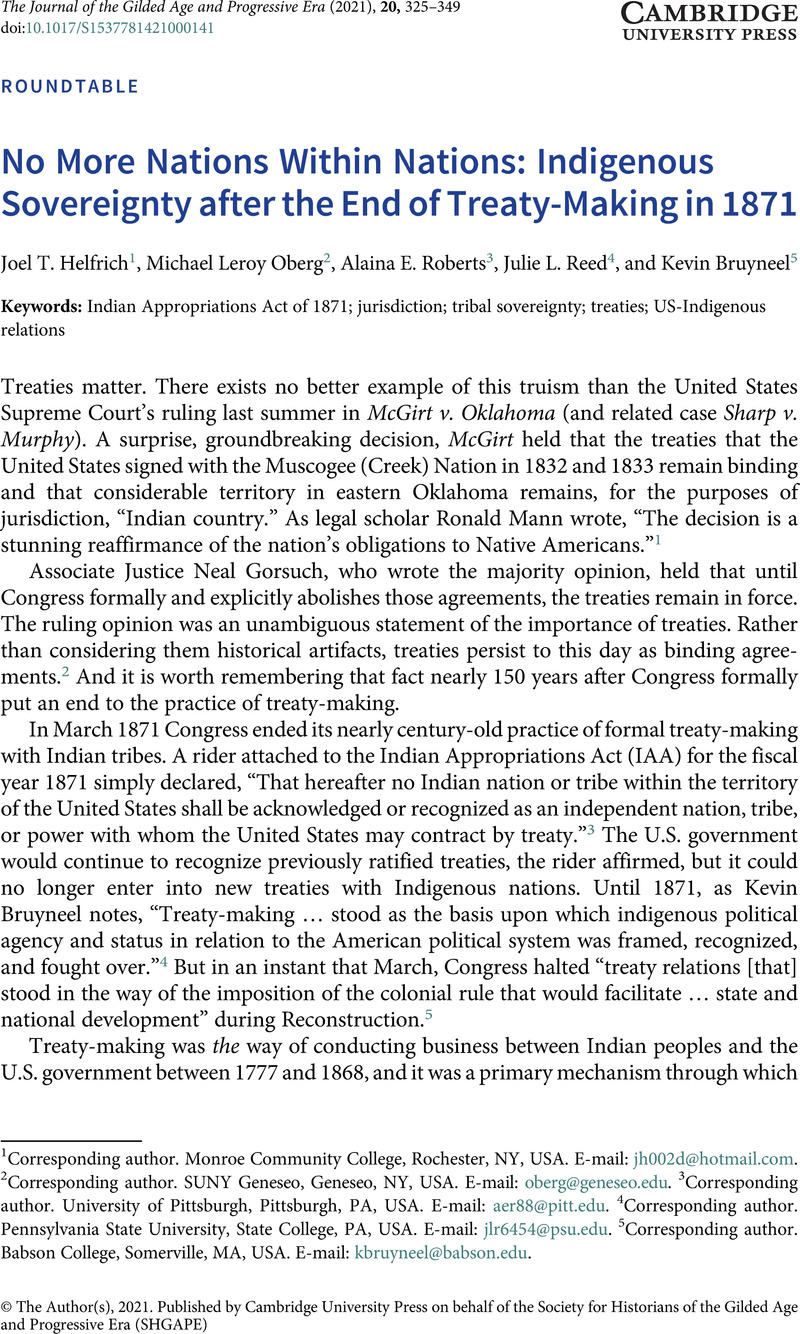Published online by Cambridge University Press: 22 April 2021

1 The Dawes Act is also known as the General Allotment Act or the Dawes Severalty Act.
2 Instructions to A.P. Choteau, Special Agent to the Comanches and Others, Annual Report of the Commissioner of Indian Affairs, transmitted with the message of the president at the opening of the 2nd session of the 25th Congress, 1837–1838, United States Office of Indian Affairs, Annual Report of the Commissioner of Indian Affairs, for the years 1826–1839, 37–38; Vere, David La, Contrary Neighbors: Southern Plains and Removed Indians in Indian Territory (Norman: University of Oklahoma Press, 2000), 9–13.Google Scholar
3 Initially set aside by President Thomas Jefferson as a future habitation for southern and southeastern Indian nations who inconveniently possessed lands that white settlers most desired, Indian Territory’s borders waxed and waned through various legislation, such as the Indian Intercourse Act of 1834. The area went largely unused for this purpose until Andrew Jackson’s presidency. Bailey, M. Thomas, Reconstruction in Indian Territory: A Story of Avarice, Discrimination, and Opportunism (Port Washington, NY: Kennikat Press, 1972), 5–6.Google Scholar
4 Abel, Annie Heloise, The American Indian as Slaveholder and Secessionist (Cleveland: The Arthur H. Clark Company, 1919), 252–69.Google Scholar
5 United States Office of Indian Affairs, “Southern Superintendency,” Annual report of the commissioner of Indian affairs, for the year 1862, 167–68, http://digital.library.wisc.edu/1711.dl/History.AnnRep62 (accessed Dec. 2, 2019).
6 United States Office of Indian Affairs, “Southern Superintendency,” 137.
7 Abel, Annie Heloise, The American Indian as Participant in the Civil War (Cleveland: The Arthur H. Clark Company, 1919), 223–24.Google Scholar
8 Thomas Spence, The settler’s guide in the United States and British North American provinces adapted to benefit the settlers in the various states and territories, being a synoptical review of the soil, climate, cereal, and other productions, with the minerals, manufactures, etc., etc., of each state separately; carefully arranged and compiled from manufacturing reports, state documents, and stand-alone works now extant, as well as personal observation and notes (New York: Davis & Kent Publishers, 1862), 234.
9 “An Act to Secure Homesteads to Actual Settlers on the Public Domain,” A Century of Lawmaking for a New Nation: U.S. Congressional Documents and Debates, 1774–1875, https://memory.loc.gov/cgi-bin/ampage?collId=llsl&fileName=012/llsl012.db&recNum=423 (accessed Apr. 5, 2020). While this land was “free,” there were restrictions put upon who could claim it (for instance, you had to be a head of household), and there were permit fees involved.
10 The opening of the Unassigned Lands in 1889 then made a large portion of the lands formerly claimed by the Five Tribes eligible for homesteading through the act.
11 Rubin, Anne S., A Shattered Nation: The Rise and Fall of the Confederacy, 1861–1868 (Chapel Hill: University of North Carolina Press, 2005), 143, 152Google Scholar; McPherson, James M., Battle Cry of Freedom: The Civil War Era (New York: Oxford University Press, 1988), 849.Google Scholar
12 “Treaty with the Choctaw and Chickasaw, 1866,” https://dc.library.okstate.edu/digital/collection/kapplers/id/26759 (accessed May 5, 2016); Clara Sue Kidwell, The Choctaws in Oklahoma: From Tribe to Nation, 1855–1970 (Norman: University of Oklahoma Press, 2007), 19. The Treaty of 1855, between the United States and the Choctaw Nation, had already provided a precursor for railroads through the nation, as well as for the settlement of Wichita Indians and related nations.
13 United States, U.S. Bureau of the Census, Extra Census Bulletin: The Five Civilized Tribes of the Indian Territory (Washington, DC: Government Printing Office, 1894), 7–8; United States, U.S. Bureau of the Census, Statistics for Oklahoma, Thirteenth Census of the United States, 1910 (Washington, DC: Government Printing Office, 1913), 695. The “Black” population figure includes African Americans from the United States and the former slaves of Indians and their descendants.
14 United States, “Report of the Commissioner of Indian Affairs,” in Annual Report of the Commissioner of Indian Affairs, for the year 1900, 1899–1900, 116. http://images.library.wisc.edu/History/EFacs/CommRep/AnnRep1900p1/reference/history.annrep1900p1.i0003.pdf (accessed Aug. 24, 2020).
15 Joyce Ann Kievit, “Trail of Tears to Veil of Tears: The Impact of Removal on Reconstruction” (PhD diss., University of Houston, 2002), 227–29.
16 Kidwell, The Choctaws in Oklahoma, 89.
17 Oyez, “Carpenter v. Murphy,” https://www.oyez.org/cases/2018/17-1107 (accessed July 20, 2020).
18 Supreme Court of the United States, McGirt v. Oklahoma, https://www.supremecourt.gov/opinions/19pdf/18-9526_9okb.pdf (accessed July 21, 2020).